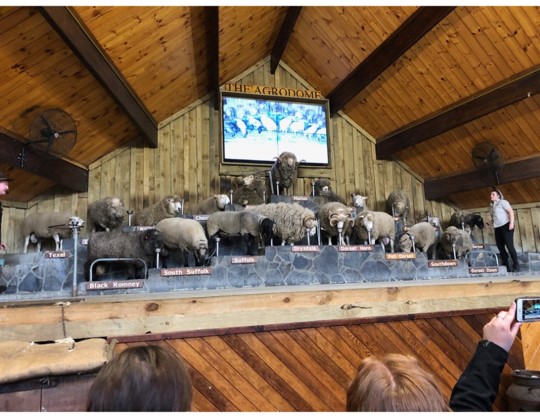Day 4
 |
| Agrodome in Roturoa, with a Merino sheep front and center. |
Agrodome
On the morning of May 10th, we attended a show at
the Agrodome where we learned about different breeds of sheep in New Zealand
and also about sheep shearing. New Zealand is home to approximately 19
different breeds of sheep including Merino, Romney, Corriedale, Cheviot, Texel,
Lincoln, Perendale, Black Romney, South Suffolk, Suffolk, Drysdale, Dorset
Horn, Poled Dorset, Southdown, Dorper, Border Leicester, English Leicester,
Coopworth, and Dorset Down. Professional sheep shearer, Scott, gave a
demonstration on how to shear a sheep and handle a sheep properly when
shearing. At the end of the presentation, Scott brought out a few of his herding
dogs which were mixed breeds specialized in either hunting or barking. We
enjoyed getting to see the dogs in action and saw how the dogs can pick out a
specific sheep from the flock.
 |
| The Maori culture had their children learn disciplines at the ages of 15-18 and these traditions are continued till this day. |
Maori
We learned about the Maori people when visiting the thermal
reserves, Te Puia, in Rotorua, which are similar to what you might find at
Yellowstone National Park in the U.S. The Maori people settled New Zealand
around the 1300’s and it is believed that their ancestors found the island
between 700-1200AD. They came from the Polynesian triangle which encompasses
the Hawaiian Islands to the Easter Islands of Chile to the New Zealand Islands.
This was discovered due to cultural traditions, oral history, and similar
religious beliefs. The Maori people used stars and birds in order to sail their
boats across the ocean. Their boats were hand carved from very large trees
found naturally in the area. At an age between 15 and 18 years old, they would
learn the trades of their people and this included boat crafting, stone and bone
carving for men, and basket/clothing weaving for women. Today, there is an
institute where young Maori can go to learn these trades which is important to
keeping their culture and lifestyles alive.
 |
| The Maori used canoes like this one to travel across the vast Pacific Ocean. |
 |
| The Maori carved faces of special chiefs on poles around their village. |
We went to a Maori cultural experience and learned more
about the Maori culture. They welcomed us into their community village, which
they consider their home, where we got to experience songs, dance, and food
from their culture. Some of the students from SDSU got to participate in the
festivities by doing dances and playing games. In order to get into the
village, we needed a chief so we elected Jon Hansen. He took charge and brought
us through all of the activities and ended the day with an emotional speech and
led us in singing the Star Spangled Banner.
 |
| This is our
mighty Chief Jon and a Maori warrior, after the peace
palm offering.
|
 |
| Here are Adam and
Denver with their new Maori brothers after
the
traditional Haka (Maori war dance greeting).
|
 |
| Maori brothers
playing and singing a traditional song before our feast. |
Dairy Farm
We also visited a dairy farm while in Rotorua, which
introduced us to Matt, a 50/50 sharemilker where they run around 2,000 head of
kiwi cross cattle, which is a Fresian/Jersey cross. He is a low input farmer
and focuses on maximizing liter per cow during the milking season in NZ. They
calve once in the spring and milk through to the fall and are dry during the
winter months. This is due to grass growth and distance required for the cattle
to walk to the milking shed, which prevents them from having to buy excess feed
for their cattle. In New Zealand, farmers rely on their ryegrass and orchard
grass mixed pastures to provide the correct nutrition for their dairy cattle.
They reseed 8-10% of their pastures each year in order to keep up with this. The
dairy we visited was located on the volcanic valleys of NZ which are heavy in
rich soils and a temperate climate and is also is great for growing grasses.
 |
| This is called The Volcanic Valley. The area around Roturoa is located at the center of a volcano that collapsed. This area is largely used for dairying and sheep production. |
 |
| Here is our group photo at the dairy on The Maori trust lands |




Comments
Post a Comment